
Mission Santa Barbara is a Spanish mission in Santa Barbara, California. It was founded by Padre Fermín Lasuén for the Franciscan order on December 4, 1786, the feast day of Saint Barbara, as the tenth mission for the religious conversion of the indigenous local Chumash-Barbareño tribe of Native American people. The mission is the namesake of the city of Santa Barbara as well as of Santa Barbara County.
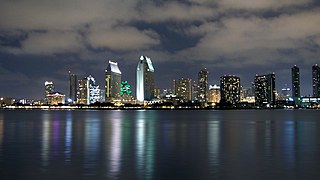
Southern California is a geographic and cultural region that generally comprises the southern portion of the U.S. state of California. It includes the Los Angeles metropolitan area, the second most populous urban agglomeration in the United States. The region generally contains ten of California's 58 counties: Imperial, Kern, Los Angeles, Orange, Riverside, San Bernardino, San Diego, Santa Barbara, San Luis Obispo and Ventura counties. The Colorado Desert and the Colorado River are located on southern California's eastern border with Arizona, and San Bernardino County shares a border with Nevada to the northeast. Southern California's southern border with Baja California is part of the Mexico–United States border.

Santa Cruz is the county seat and largest city of Santa Cruz County, California. As of 2019, the U.S. Census Bureau estimated Santa Cruz's population at 64,608.
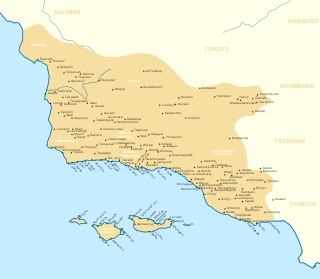
The Chumash are a Native American people of the central and southern coastal regions of California, in portions of what is now San Luis Obispo, Santa Barbara, Ventura and Los Angeles counties, extending from Morro Bay in the north to Malibu in the south. Their territory included three of the Channel Islands: Santa Cruz, Santa Rosa, and San Miguel; the smaller island of Anacapa was likely inhabited seasonally due to the lack of a consistent water source.

Santa Barbara is a coastal city in Santa Barbara County, California, of which it is also the county seat. Situated on a south-facing section of coastline, the longest such section on the West Coast of the United States, the city lies between the steeply rising Santa Ynez Mountains and the Pacific Ocean. Santa Barbara's climate is often described as Mediterranean, and the city has been promoted as the "American Riviera". The official 2020 population was 88,665.
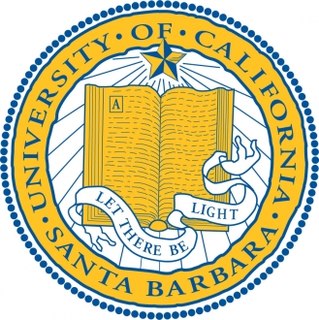
The University of California, Santa Barbara is a public land-grant research university in Isla Vista, California. It is part of the University of California system. Tracing its roots back to 1891 as an independent teachers' college, UCSB joined the University of California system in 1944, and is the third-oldest undergraduate campus in the system, after UC Berkeley and UCLA.

The Vatican Museums are the public museums of the Vatican City. They display works from the immense collection amassed by the Catholic Church and the papacy throughout the centuries, including several of the most renowned Roman sculptures and most important masterpieces of Renaissance art in the world. The museums contain roughly 70,000 works, of which 20,000 are on display, and currently employ 640 people who work in 40 different administrative, scholarly, and restoration departments.

Georgia Totto O'Keeffe was an American artist. She was known for her paintings of enlarged flowers, New York skyscrapers, and New Mexico landscapes. O'Keeffe has been recognized as the "Mother of American modernism".

Bruce Alan Brown was an American documentary film director, known as an early pioneer of the surf film. He was the father of filmmaker Dana Brown.

The Santa Barbara Museum of Art (SBMA) is an art museum located in downtown Santa Barbara, California.
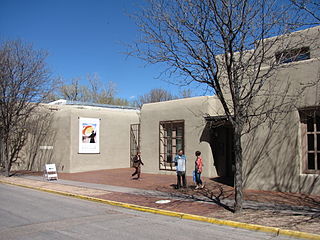
The Georgia O'Keeffe Museum is dedicated to the artistic legacy of Georgia O'Keeffe, her life, American modernism, and public engagement. It opened on July 17, 1997, eleven years after the artist's death. It comprises multiple sites in two locations: Santa Fe, New Mexico, and Abiquiu, New Mexico. In addition to the founding Georgia O'Keeffe Museum in Santa Fe, the O'Keeffe includes: the Library and Archive within its research center at the historic A.M. Bergere house; the Education Annex for youth and public programming; Georgia O'Keeffe's historic Abiquiu Home and Studio; the O'Keeffe Welcome Center in Abiquiu; and Museum Stores in both Santa Fe and Abiquiu. Georgia O'Keeffe's additional home at the Ghost Ranch property is also part of the O'Keeffe Museum's assets, but is not open to the public.
Sandow Birk is an American visual artist from Los Angeles whose work deals mainly with contemporary American culture. Seven books have been published on his works and he has made two films. With an emphasis on social issues, his frequent themes have included inner city violence, graffiti, various political issues, travel, prisons, surfing and skateboarding. His projects are often elaborate and epic in scale, including a series on "The Leading Causes of Death in America" and the invasion and the second war in Iraq. He completed a hand-made illuminated manuscript version of the Qur'an, transcribing the English language text by hand in a personalized font based on graffiti, and illuminating the pages with scenes of contemporary American life.

The Santa Cruz Museum of Natural History, also known affectionately by locals as "the Whale Museum", is one of the earliest museums in the state of California. Founded from the Laura Hecox collection in 1905, the Museum's collections grew extensively throughout the years, acquiring many Native American and archaeological artifacts, as well as natural history specimens. Currently, the Museum is housed in a Carnegie Library, named after the Carnegie philanthropic foundation that funded the construction of the library in 1915.
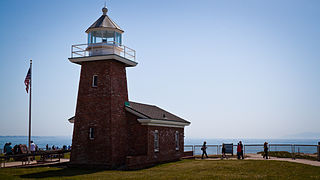
The Santa Cruz Surfing Museum is a museum which was established in May 1986 to document the history of surfing. With collections dating back to the earliest years of surfing on mainland United States, the museum houses a historical account of surfing in Santa Cruz, California.

The Santa Barbara International Film Festival (SBIFF) is an eleven-day film festival held in Santa Barbara, California since 1986.
The culture of California is tied to the culture of the United States as a whole. However, there are features that are unique to California. With roots in the cultures of Spain, Asia, Mexico, and the eastern United States, California integrates foods, languages and traditions from all over the world.
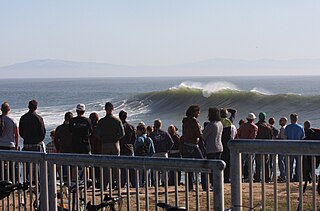
Steamer Lane is a famous surfing location in Santa Cruz, California. It is just off a point on the side of cliffs in the West Cliff residential area near downtown Santa Cruz, providing easy access and a good vantage point for viewing. The Santa Cruz Surfing Museum is housed in a lighthouse there. "Steamer Lane" is the preferred form of the name used by the people surfing there. Steamer Lane was named by Claude Horan while he was a student at San Jose State in the late 1930s. One flat calm day he and his friend Wes Hammond thought it would be a good idea to hire steamships to cruise back and forth to generate waves for surfing. It was at Steamer Lane that the modern surfing wetsuit and the leash were mainly developed by Jack O'Neill, who had his surf shop nearby for many years.

Jack O'Neill was an American businessman, often credited with the invention of the wetsuit, and the founder of the surfwear and surfboard company O'Neill.
Juice Magazine, founded in 1993 in Wilmington, North Carolina, is a skateboarding, surfing and music publication, edited, owned and published by Terri Craft. It includes interviews by skate editor, Jim Murphy, and features editors: Steve Olson, Jay Adams, Dave Duncan, Christian Hosoi, Jim O'Mahoney, and surf editors Jeff Ho, Herbie Fletcher and Dibi Fletcher. The staff includes Terri Craft, Editor and Dan Levy, Assistant Editor. Other interviewers include Jason Jessee, Jeff Ament, Chuck Dukowski, Bill Danforth and Chris Mearkle. There are currently 76 issues of the magazine. Juice Magazine headquarters is located in the birthplace of modern-day skateboarding, Venice, California.

Young Mother Sewing aka Little Girl Leaning on her Mother's Knee is a 1900 painting by Mary Cassatt. It is in the collection of the Metropolitan Museum of Art.

















